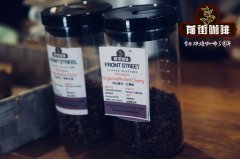How is Ethiopian coffee traded? introduction to the price of Ethiopian coffee beans.

Professional coffee knowledge exchange More coffee bean information Please pay attention to coffee workshop (Weixin Official Accounts cafe_style)
According to Ethiopian law, there are three coffee export systems: (1) the largest private processing plant system through ECX bidding;(2) cooperative system; and (3) single farm system. Of these three systems, cooperatives and single farms are not directly exported without ECX bidding, and can be said to have completely reliable traceability/product traceability.
However, if we go back to the bottom, after all, co-operatives are purchasing cherries harvested by small farmers for centralized processing, and they are not 100% traceable. A single farm is, after all, the only possibility of moving forward to the next generation.
Source: ECX
Ethiopia Ethiopia Commodity Exchange
The Ethiopia Commodity Exchange (ECX) was founded in 2008 by Eleni Gabre-Madhin, a former World Bank senior economist and director of the International Food Policy Research Institute (IFPRI). The original intention of ECX was to establish the first commodity exchange in Ethiopia and even Africa. By introducing modern trading rules and technologies such as pricing mechanism, warehousing logistics and instant communication means, ECX changed the situation of high transaction risk and high transaction cost in Ethiopian agricultural products market and built an effective, reliable and transparent commodity market.
ECX was widely acclaimed at its inception as transforming Ethiopian agriculture and reducing famine and poverty. In the past, Ethiopian farmers have often been accused of providing market access to more than 2.4 million smallholder farmers through rural cooperatives, as claimed by ECX in overwhelming media coverage.
ECX's coffee trading model goes something like this: First, farmers sell coffee berries to local washing plants, some of which pay higher prices for better quality coffee berries. The processing yard will deliver the processed raw beans to the warehouse of the delivery station.
ECX is equivalent to a "distribution center", which does the following:
1. With better price protection, it buys coffee beans from coffee farmers at a constant and better price and stores them.
2. Coffee classification, the best price is higher;
3. Information timely, coffee farmers can call, immediately get the transaction price, the regional processing station, the regional coffee warehouse and other information;
4. Establishment of storage & processing plants, as of 2012, Ethiopia has 56 warehouses distributed in 17 locations, 9 of which have coffee warehouses, reducing transportation costs.
For example, in the Yerca Sherphine region, the delivery point is Dila, and the raw beans are labeled according to the production area and graded according to the quality and quality of the raw beans. The higher the overall quality, the higher the selling price. Traders buy raw beans through ECX, but the packaging only indicates the origin and village, such as "Yirgacheffe: Konga"(Yirgacheffe: Konga). Yirgacheffe: Kochere
Ethiopian Coffee Cooperative
Farmers 'Cooperative Union
In order to facilitate the direct export of farmers 'cooperatives to the outside world, farmers' cooperatives in various places have set up their own cooperative unions. At present, there are 6 Farmers 'Cooperative Unions in Ethiopia, namely
● Oromia Coffee Farmers Cooperative Union (OCFCU)
● Sidama Coffee Farmers Cooperative Union (SCFCU)
● Yirgacheffe Coffee Farmers Cooperative Union (YCFCU)
● Kafa Forest Coffee Farmers Cooperative Union (KFCFCU)
● Bench Maji Coffee Farmers Cooperative Union (BMCFCU)
● Tepi Coffee Farmers Cooperative Union (TCFCU)
The advantage of cooperative alliance is to unite scattered small farmers with cooperatives to form a large collective, participate in international projects, such as Firetrade, provide a unified export to contact buyers, pay a certain proportion of the harvest to cooperatives, deduct management expenses, reserve part for community development, and pay the rest to small farmers. Small farmers can obtain income more stably and conveniently to meet planting and living expenses. This is why more and more smallholders are willing to join cooperatives.
Sisiga Cooperative (1600-2500 m)
Region: Gedeo-Kochere Kochere
Number of members: 1862
Land Attribute: Red Brown Soil
Certificates: Fair Trade, UTZ Sustainable Grown, Organic Coffee
Finchewan Cooperative (1450- 2000m)
Origin: Gedeo-Wenago
Number of members: 1,271
Land attribute: Red Brown Soil
Certificate: Fair Trade, Organic Coffee
Konga Konga Cooperative (1750- 2300m)
Production area: Gedeo-Yejia Shefei
Number of members: 1,556
Land Attribute: Red Brown Soil
Certificate: Fair Trade, Organic Coffee
Hafursa Cooperative (1750-2300 m)
Production area: Gedeo-Yejia Shefei
Number of members: 1975
Land attribute: Red Brown Soil
Annual production of green coffee beans: 798000 kg
Average farm size: maximum 4 hectares, annual yield of approximately 600 kg per hectare
Cooperative has washing station
Certificate: Fair Trade, Organic Coffee
Resa Cooperative (1000-1400 m)
Origin: Gedeo-Wenago
Number of Members: 2,719
Land attribute: Red Brown Soil
Two sets of coffee processing equipment available
Certificate: Fair Trade, Organic Coffee
Addis Katema Cooperative (1000-1400 m)
Origin: Gedeo-Wenago
Number of members: 891
Cooperative has washing station
Land Attribute: Red Brown Soil
Certificate: Fair Trade, Organic Coffee
Biloya Cooperative (1600-2500 m)
Region: Gedeo-Kochere Kochere
Number of members: 1,203
Land Attribute: Red Brown Soil
Two sets of coffee processing equipment
Certificate: Fair Trade, Organic Coffee
Worka Woka Cooperative (1650-2700 m)
Production area: Gedeb
Number of members: 305
Land attribute: Red Brown Soil
Annual production of green coffee beans: 457000 kg
Average farm size: maximum 4 hectares, annual yield of approximately 699 kg per hectare
Cooperatives have all the treatment equipment
Certificate: Fair Trade, Organic Coffee
Koke Co-op (1750-2300 m)
Production area: Gedeo-Yejia Shefei
Number of members: 828
Land attribute: Red Brown Soil
One set of treatment devices available
Certificates: Fair Trade, UTZ Sustainable Grown, Organic Coffee
Hama Cooperative (1600-2500 m)
Region: Gedeo-Kochere Kochere
Number of members: 1,505
Land attribute: Red Brown Soil
One set of treatment devices available
Certificate: Fair Trade, Organic Coffee
Chichu Cooperative (1410- 2000m)
Production area: Gedeo-Dila
Number of members: 1,675
Land attribute: Red Brown Soil
Average farm size: maximum 4 hectares, annual yield of approximately 591 kg per hectare
One set of treatment devices available
Certificate: Fair Trade, Organic Coffee
Michile Cooperative (1410-2000 m)
Production area: Gedeo-Dila
Number of members: 1,206
Land attribute: Red Brown Soil
Average farm size: Annual yield of approximately 592 kg/ha
One set of treatment devices available
Certificates: Fair Trade, UTZ Sustainable Grown, Organic Coffee
Hase Haro Cooperative (1450- 2000m)
Origin: Gedeo-Wenago
Number of members: 1,519
Land attribute: Red Brown Soil
Average farm size: maximum 4 hectares, annual yield of approximately 591 kg per hectare
One set of treatment devices available
Certificate: Fair Trade, Organic Coffee
Dumerso Cooperative (1750-2300 m)
Production area: Gedeo-Yejia Shefei
Number of members: 246
Land attribute: Red Brown Soil
Two sets of treatment devices available
Certificate: Fair Trade, Organic Coffee
Tumticha Cooperative (1410- 2000m)
Production area: Gedeo-Yejia Shefei
Number of members: 960
Land attribute: Red Brown Soil
Two sets of treatment devices available
Certificate: Fair Trade, Organic Coffee
Aramo Cooperative (1750-2300 m)(90+ Clinique)
Production area: Gedeo-Yejia Shefei
Number of members: 2,254
Land attribute: Red Brown Soil
Two sets of treatment devices available
Certificate: Fair Trade, Organic Coffee
Edido Cooperative (1750- 2300m)
Production area: Gedeo-Yejia Shefei
Number of members: 1044
Land attribute: Red Brown Soil
One set of treatment devices available
Certificate: Fair Trade, Organic Coffee
Adame Cooperative (1000-1400 m)
Origin: Gedeo-Wenago
Number of members: 533
Land attribute: Red Brown Soil
One set of treatment devices available
Certificate: Fair Trade, Organic Coffee
Belekara Cooperative (1000-1400 m)
Origin: Gedeo-Wenago
Number of members: 685
Land attribute: Red Brown Soil
One set of treatment devices available
Certificate: Fair Trade, Organic Coffee
Adado Cooperative (1200-1700 m)
Production area: Sidamo-Bule
Number of members: 1,128
Land attribute: Red Brown Soil
One set of treatment devices available
Certificate: Fair Trade, Organic Coffee
Haru Cooperative (1200-1700 m)
Production area: Gedeo-Yejia Shefei
Number of members: 1,187
Land attribute: Red Brown Soil
One set of treatment devices available
Certificate: Fair Trade, Organic Coffee
In July 2017, two new coffee trade regulations could change this by giving coffee farmers the option to sell coffee beans to coffee processing plants within three days of their arrival at ECX warehouses.
Ethiopian Coffee Bean Single Farm
The system has always existed in Ethiopia, but it has not been a high proportion, and it has traditionally been a large commercial batch that does not pay attention to quality. With Ethiopia's emergence in the third wave of fine coffee in the past 20 or 30 years, in addition to traditional coffee practitioners, Ethiopia has gradually emerged a group of new talents influenced by western culture and hoping to bring changes to this industry. In addition to traditional exporters putting into production, it has also attracted a group of upsurge returning from Europe and America to their hometown.
How important is the Single Farm Project (SFP)? We all know that Ethiopia is dominated by smallholder systems, but it is impossible to achieve complete traceability in smallholder systems.
Single farms are the only answer to all these questions. Single variety batches, special treatment batches, customized batches, etc. Fine coffee development is a very important implementation concept,
For example, this bean belongs to a single farm, the micro-production area Hambella Hambella Manor.
Ethiopia Hambera Manor Single Farm Holy Lion Village
Ethiopia Hambela Benti Nenqua G1
Country: Ethiopia
Origin: Oromia Region
Guji Zone
Hambela Woreda
Benti Nenqua Kebele
Altitude: 2,150 m (GPS measurement height of treatment plant)
Breed: Heirloom
Annual rainfall: 1,500 - 2,000 mm
Treatment plant: Hambela
Ethiopian coffee beans
Front Street Coffee roasts Ethiopian coffee beans with full guarantees of brand and quality. More importantly, the cost performance is extremely high, a pack of half pounds 227 grams, the price is only about 90 yuan. According to the calculation of 15 grams of powder per cup of coffee, a pack can make 15 cups of coffee, each cup only costs about 6 yuan, compared with the coffee shop sells hundreds of dollars a cup price can be regarded as conscience recommendation.
Related recommendations: Ethiopia YCFCU Cooperative Several characteristics of varieties recommended Introduction Flavor Description
Important Notice :
前街咖啡 FrontStreet Coffee has moved to new addredd:
FrontStreet Coffee Address: 315,Donghua East Road,GuangZhou
Tel:020 38364473
- Prev

The Origin of Panamanian Rose Summer Coffee the difference between Panamanian Rose Summer Coffee and Ethiopia Rose Summer Coffee
For more information about coffee beans, please follow the coffee workshop (official account cafe_style of Wechat) | Geisha, a variety first discovered in the rose forest of Ethiopia in 1931 and later sent to the Coffee Research Institute in Kenya. Introduced to Uganda and Tanzania in 1936; introduced to Costa Rica in 1953
- Next

Ethiopian coffee beans knowledge what kind of coffee can be called Yega Xuefei?
Professional coffee knowledge exchange more information on coffee beans please follow the coffee workshop (Wechat official account cafe_style) Yegashafi coffee beans, the earliest definition is produced in Ethiopia, a coffee bean called the town of Yegashefi. Most coffee fans may be no stranger to Ethiopia, which is the birthplace of Arabica and the most important native / wild in the world
Related
- Beginners will see the "Coffee pull flower" guide!
- What is the difference between ice blog purified milk and ordinary milk coffee?
- Why is the Philippines the largest producer of crops in Liberia?
- For coffee extraction, should the fine powder be retained?
- How does extracted espresso fill pressed powder? How much strength does it take to press the powder?
- How to make jasmine cold extract coffee? Is the jasmine + latte good?
- Will this little toy really make the coffee taste better? How does Lily Drip affect coffee extraction?
- Will the action of slapping the filter cup also affect coffee extraction?
- What's the difference between powder-to-water ratio and powder-to-liquid ratio?
- What is the Ethiopian local species? What does it have to do with Heirloom native species?

